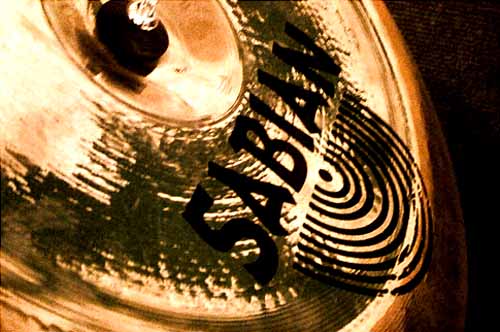When choosing a China cymbal, you want to think about the other equipment in your kit, considering how the new cymbal will balance with the rest in terms of both tone and volume. Whatever your stylistic inclinations, one of the China cymbals on this list is guaranteed to give your sound the trashy, bright edge you’ve been looking for.
These are our recommendations for the 4 best china cymbals on the market:
Zildjian A Custom 18” China Cymbal
Zildjian is one of the world’s leaders in percussion equipment, and their 18” custom China cymbal gives you the balance of piercing volume and musicality you want out of this style of cymbal. They’re hammered using radical rotary techniques and thin weights, giving the cymbal a brilliant, crisp finish with a sweet sound sophisticated enough for softer styles, like jazz, as well as harder rock styles. It’s hammered thin for an explosive sound with a sharp attack and a smooth decay. Hit it hard for the full China texture, or use it lightly to add shimmer and texture to your kit sound.
Sabian 18″ XSR1807B China Cymbal
This Sabian model is hammered thin for a bright and aggressive sound that’s got a lot of grit and an impressive sustain. The cymbals sharp attack and raw, tight tone makes it extremely versatile, and it can function in your rack as a ride cymbal, a second crash cymbal, or just to add texture and color.
The feel of it is also different than many China cymbals on the market, giving you a wide range of sounds in response to your touch. Play it lightly on the edge for a soft, warm shimmer or get an explosion of trashy power when you hit it with force. It also blends well with other cymbals, making it a great addition to any rack. It’s easily one of the best china cymbals out there.
Wuhan WU10420 China Cymbal
You might be surprised to learn a large company like Wuhan still uses the same techniques employed in China thousands of years ago, methods that give their China cymbals a uniquely rich and powerful sound. The cymbal is cast in a B20 alloy then hammered by hand, giving you a darker sound than most Turkish or European style cymbals that still has the power, grit, and edge you look for in a China cymbal. They often retail for about half the price of other professional brands—especially surprising, when you consider the handcrafting that goes into each cymbal’s production.
Paiste PST 3 China Cymbal

- Paiste PST 3 Cymbal China 18-inch
- Price: $99.99
-

- Price as of 04/19/2024 11:59 PDT(more info about ad)

Paiste brings an impressive mix of value and quality with their PST line of cymbals. The China cymbal from the line is a bit cleaner than some other brands’ China cymbals. This is partially because it’s heavier than many China cymbals—a medium-heavy weight that gives it a full, dark tone with a trashy edge and a quick response. This extra weight also gives the cymbal more power and volume, perfect for players in heavier styles. The sustain is also fairly short with a lively attack—and you get this impressive sound for this price range. It’s likely the best china cymbal for the money.
Size Considerations When Selecting China Trash Cymbals
There are two important size factors that determine the basic tonal qualities of a China cymbal: the diameter and the weight, or thickness. You can find China-type cymbals in a wide array of sizes, from tiny cymbals that are less than an inch across to massive 27 inch models. In the modern market, China cymbals that are smaller than 12 inches tend to be classified as “splash” cymbals, with the term China cymbal or trash cymbal applying to those 12 inches or larger.
Generally speaking, the larger the cymbal’s diameter, the lower the pitch and the longer the sustain. Larger cymbals also tend to be louder than smaller cymbals of the same thickness. For most western styles, the ideal size is between 16 and 20 inches, though players in very heavy styles may want a larger cymbal to give them more power.
The thickness of the cymbal is another factor to consider. Thinner cymbals tend to be more responsive, giving you a more varied and subtle sound palate. Thicker cymbals have a higher pitch and a longer sustain than thinner cymbals of the same size. The combination of size and thickness will let you fine-tune the qualities you’re looking for out of a cymbal.
If you like the power you get out of a China cymbal but want less sustain, look for a thinner model of the same size. You can get a general sense of the size and thickness of a cymbal by considering its weight, which is determined through a combination of the above factors.
China Cymbals: Construction Style
There are three major techniques used to construct China cymbals, defined by their general geographic origin: Chinese, Turkish, and European.
The Chinese-style China cymbal is the original technique and was derived most obviously from gongs. You can often see the difference between the styles in the bell—the central part of the cymbal that’s raised on most models. Chinese-style cymbals have a pronounced, square-ish bell. The outer edge of a Chinese-style cymbal typically sweeps slightly upward, giving the overall profile a subtle bowl-like shape. This style tends to have a deep, round tone with a long sustain.
Turkish and European styles are more similar to each other, and differentiating between the two can sometimes be difficult. Turkish China cymbals have a more subtle, rounded bell, and may or may not turn up on the outer edge. Their sound has more of a swell and is often described as “sweet.” Both styles give you a bright, cutting tone, with lots of dirt to the sound giving it the “trashy” tone so sought after by Western drummers. The Zildjian cymbal (see full specs) above is a prime example of the Turkish style, while the European style is exemplified by the Paiste model (see full specs).
Whichever style you choose, though, we’re sure you’d be pleased with any of the four cymbals above. They should be on anyone’s list of the best china cymbals. Good luck!







